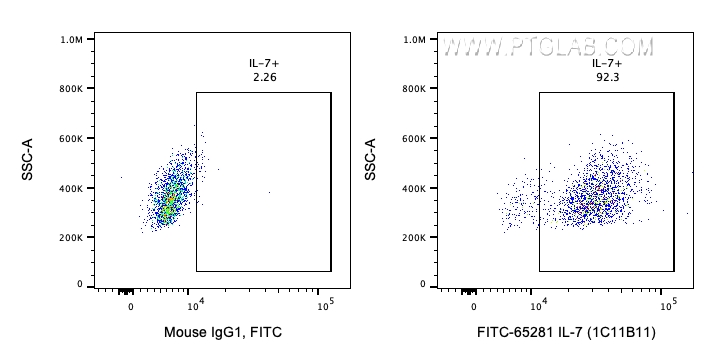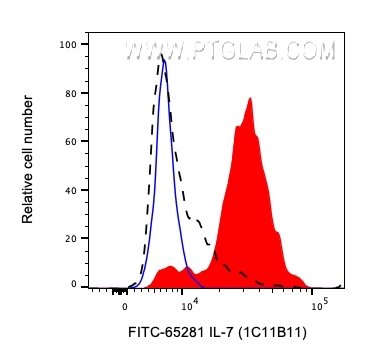验证数据展示
经过测试的应用
| Positive FC (Intra) detected in | LPS and Brefeldin A treated human PBMCs |
| Positive FC detected in | LPS and Brefeldin A treated human PBMCs |
推荐稀释比
| 应用 | 推荐稀释比 |
|---|---|
| Flow Cytometry (FC) (INTRA) | FC (INTRA) : 0.2 ug per 10^6 cells in 100 μl suspension |
| Flow Cytometry (FC) | FC : |
| This reagent has been tested for flow cytometric analysis. It is recommended that this reagent should be titrated in each testing system to obtain optimal results. | |
| Sample-dependent, Check data in validation data gallery. | |
产品信息
FITC-65281 targets IL-7 in FC (Intra) applications and shows reactivity with Human samples.
| 经测试应用 | FC (Intra) Application Description |
| 经测试反应性 | Human |
| 免疫原 |
Product name: HumanKine® recombinant human IL-7 protein Source: -derived, Tag: Sequence: 种属同源性预测 |
| 宿主/亚型 | Mouse / IgG1 |
| 抗体类别 | Monoclonal |
| 产品类型 | Antibody |
| 全称 | interleukin 7 |
| 别名 | IL7, IL-7, interleukin 7, Interleukin-7, 1C11B11, IL 7 |
| 计算分子量 | 20 kDa |
| GenBank蛋白编号 | BC047698 |
| 基因名称 | IL-7 |
| Gene ID (NCBI) | 3574 |
| RRID | AB_3085008 |
| 偶联类型 | FITC Plus Fluorescent Dye |
| 最大激发/发射波长 | 495 nm / 524 nm |
| 形式 | Liquid |
| 纯化方式 | Affinity purification |
| UNIPROT ID | P13232 |
| 储存缓冲液 | PBS with 0.09% sodium azide and 0.5% BSA, pH 7.3. |
| 储存条件 | Store at 2-8°C. Avoid exposure to light. Stable for one year after shipment. |
背景介绍
Interleukin-7 (IL-7) is a cytokine involved in B and T cell development. It plays an active role in the development, survival, maintaining and restoring homeostasis of mature T lymphocytes and is a key regulator of the commitment, survival, proliferation and maturation of B cells during development. Furthermore, IL-7 can improve the antiviral function and expansion of natural killer (NK) cells and regulate the development and differentiation of dendritic cells. IL-7 has also been reported as a regulator of the development of central nervous system and myogenesis and skeletal muscle cell migration. (PMID: 29663382; 29655570; 29449560)
实验方案
| Product Specific Protocols | |
|---|---|
| FC protocol for FITC Plus IL-7 antibody FITC-65281 | Download protocol |
| Standard Protocols | |
|---|---|
| Click here to view our Standard Protocols |



